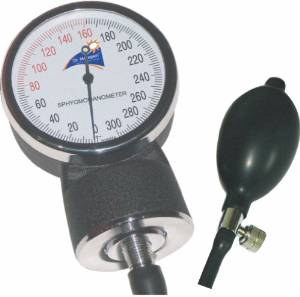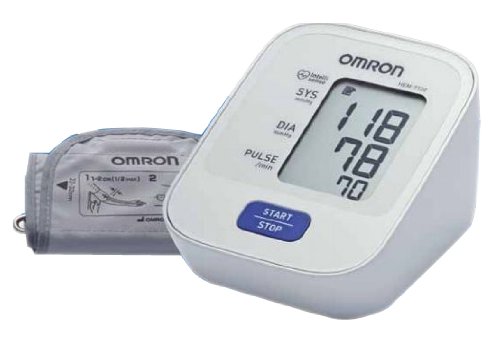Hypertension or high blood pressure, the notorious non-communicable disease is now a common household name. At our primary health center, I had patients belonging to all the socio-economic groups who are suffering from this disease.
Modifying the lifestyle, making the correct dietary changes, reducing the consumption of salt in the diet and strictly taking the anti-hypertensive medicines are the ways to control the blood pressure and keep it in the normal range. Self-monitoring of one’s own blood pressure at home is of the utmost importance when it comes to managing hypertension. However, most of the persons get confused when it comes to choosing the right blood pressure monitor. This is simply because of the various types of blood pressure monitoring devices that are now available in the market. This article is about the different types of such monitoring devices covering the features and will definitely help you make the right decision in choosing one for your home. But, before that, I highly recommend you to read this article on high blood pressure to get the basic knowledge about the disease.
If you are still wondering about the need for buying a Blood pressure machine for use at home, watch this video first!
Types of Blood Pressure Monitoring Devices
If you didn’t know already, there is one word for these blood pressure monitoring devices. And that simple word is “Sphygmomanometer” derived from the greek word sphygmos (pulse) and the scientific term manometer (pressure machine). Now there are two types of sphygmomanometer :
Here is the video on the diffrent types of blood pressure machines that you can buy
- Manual &
- Automatic (digital)
Manual type of blood pressure monitors
The manual blood pressure monitors was invented in 1881 by Dr Samuel Karl von Basch. The device consists of an inflatable cuff which works together with a mercury or mechanical manometer. Even today, the manual type of sphygmomanometer is preferred by clinicians for their accuracy. Based on the measuring system used, the manual type of blood pressure monitors can be divided into two sub-types :
- Mercury Sphygmomanometer
- Aneroid Sphygmomanometer
A stethoscope will have to be used with these type of monitors to record the diastolic blood pressure. For recording the systolic blood pressure alone the palpation method can be used and stethoscopes are not required.
Mercury blood pressure monitor
The mercury type of sphygmomanometers are by far the most accurate ones when it comes to clinical or research purpose. The inflatable cuff is connected to a column of mercury which rises and falls according to the pressure variations made by the pump. Measurements are recorded in millimetres of mercury (mm Hg). Care must be taken while using mercury sphygmomanometers because mercury spillage can happen and can be potentially dangerous. I’d recommend it for home use only if there are medical students, healthcare workers in your home. They should not be kept within the reach of small children. Buy the mercury sphygmomanometers for use at small clinics, hospitals, laboratories etc. These type of monitors last longer and does not require any calibration. I recommend the following brands of mercury sphygmomanometers :
- Diamond mercury sphygmomanometer deluxe – INR 2000 to 2200 (My Home Device)
- ELKO mercury blood pressure mnitor – INR 2000 to 2200
- Disha mercury type sphygmomanometer – INR 1850 to 2100
 Diamond mercury blood pressure monitor
Diamond mercury blood pressure monitorAneroid blood pressure monitor
These type of monitors use a mechanical system with a dial. They do not use mercury and hence are safer than the former type of monitors. Because of the smaller size of the dial, these type of monitors are weightless and can be easily carried around. They are also inexpensive compared to the digital and mercury sphygmomanometers. Frequent calibration are needed for these type of monitors and therefore are less accurate than the mercury monitors. I recommend the following aneroid sphygmomanometers :
- Diamond dial blood pressure monitor – INR 750 to 950
- Diamond aneroid sphygmomanometer with built-in stethoscope – INR 1600 to 2200
- Rossmax GB102 Aneroid BP monitor – INR 650 to 800
- Dr Morepen aneroid BP monitor – INR 700 to 900
 Dr Morepen aneroid sphygmomanometer
Dr Morepen aneroid sphygmomanometerNOTE – You’ll need a stethoscope to record the blood pressure while using the manual type of sphygmomanometers. Click here for some of the best stethoscopes that you can easily buy online.
Digital Blood Pressure Monitor
The digital blood pressure monitors are the easiest to use and measure blood pressure. The cuff is inflated automatically by an electronic pump. Systolic and diastolic blood pressure is derived from the mean arterial blood pressure which is detected by the sensors using the oscillometric method. No special training is needed to operate a digital blood pressure machine. Stethoscopes are not required for recording the values. This is the reason what makes the digital monitors the most recommended devices for use at home. Before using the device, you’ll need to take it to your doctor to calibrate and verify the results. Most of the digital blood pressure monitors comes with additional features like displaying the pulse rate, detecting irregular heart beats, in-built memory for saving the measurements, audio notifications for high or low blood pressure and even announcing the measured value (accessibility feature for the old and blind).
 Omron HEM 7120 digital blood pressure monitor
Omron HEM 7120 digital blood pressure monitorThe digital blood pressure monitors however cannot be used in certain medical conditions such as arrythmias, pre-ecclampsia, arteriosclerosis etc. In such cases, manual sphygmomanometers should be used to record accurate blood pressure. I recommend the following brands of digital blood pressure monitors :
- Omron HEM 7120 automatic blood pressure monitor – INR 1400 to 1600
- Dr Morepen BP One automatic blood pressure monitor – INR 1100 to 1200
- Dr.Trust Automatic BP monitor – INR 2300 to 2600
- BPL Digital BP monitor – INR 2000 to 2500
MUST READ —> Top 5 digital blood pressure monitors in India
Always choose digital blood pressure monitors that uses upper arm cuffs. Cuffs for wrist and even fingers are more likely to give less accurate results. And before placing the order, make sure that the cuff size is right for you.
Choosing the right Cuff size
The width of the arm cuff should be of the right size to fit smoothly and snugly on your upper arm. Too small cuff sizes can give incorrect high blood pressure readings and large-sized cuffs can yield incorrect low blood pressure readings. Ideally, the air bladder inside the cuff should cover 80% of your arm. In order to find the right cuff size for your arm, take a piece of string and measure the circumference of your upper arm at the midpoint between shoulder and elbow. Ask for someone’s help if needed. Use the following table to find the right cuff size after taking the mid-arm circumference :
| Mid-Arm measurement in cms | Cuff Size |
|---|---|
| 17 to 22 | Small |
| 23 to 32 | Medium |
| 33 to 42 | Large |
Tips to Remember for Home BP Checking
https://youtu.be/HbUDXICbYII
Here is a list of tips and tricks that you should keep in mind before buying a blood pressure monitor for use at home :
- Always go for an automatic, upper-arm, cuff type blood pressure monitor for home use. Avoid the wrist and finger type monitors as they are likely to give less reliable results.
- Consider the manual type of sphygmomanometers only if the help of a trained healthcare worker is available in your home or household. If you already have mercury type blood pressure monitors in your home, make sure that it is beyond the reach of small children.
- Check whether the monitor is validated and approved by the various International standards
- Choose the right cuff size for reliable and accurate results
- Take the blood pressure monitor to your doctor and get it tested before using it at your home
- If you have cardiac arrythmias, arteriosclerosis, pulsus alternans, pulsus paradoxes, pregnancy induced hypertension, it would be better to choose a manual sphygmomanometer instead of the digital type
- Always write down the blood pressure values with date and time in a diary or notebook and take it with you on every appointment with your doctor
- Do frequent calibration checks if you’re using an aneroid or digital blood pressure monitor
- The cuff should be tied in such a way that it fits smoothly on the upper arm. Loosening and tightening of the cuff can give incorrect readings.
- The arm should be placed at the level of the heart, the person relaxed and not talking while taking the reading.
- In case of digital blood pressure monitors, make sure that all the 4 batteries are changed as a pack.
How helpful was this article? If you have anything more to add to this article, please do share it in the comments below. To get more such posts delivered right into your mailbox, just fill up the subscription form at the top of this page.
Dr Prasoon . I am Rambabu . I read few of your articles and found them very useful . I have a small query . I have my age old parents with me . Both are suffering from hypertension . At times it is very difficult to take them out for bp checkup . Can you pl suggest best bp monitor . People are saying that automatic ones are not accurate while conventional and Mercury models are the best . Is it so ? Pl do suggest
Thanks in advance
Hello Rambabu
Home monitoring of hypertension can easily be done with automatic digital blood pressure meters.
Its accuracy is comparable to conventional mercury sphygmomanometers. If you are looking for ease of use, go ahead with digital meters. Your parents will also find it simple to check their own blood pressure with the digital meters. Check out this link for 5 of the most popular blood pressure digital meters you can buy. Hope this helped.
Regards
very informative. keep reviewing .
best wishes.
Thanks a bunch for the kind words. I’ll do my best